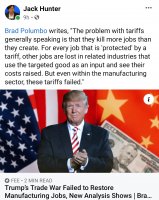Orangeburst
Attention all Planets of the Solar Federation
- Joined
- Jun 19, 2008
- Messages
- 48,166
- Likes
- 110,493
Peter Zeihan on China:
18 December 2019 by Melissa Taylor and Peter Zeihan
December 16 and 17 all the international news that was fit to print showcased announcements in both China and the United States that after some 18 months of talks, tariffs and recriminations, a Phase1 trade deal had been reached.
So we’re out of the woods? Right? The threat to the global trading system is now addressed?
Um, no.
Trade deals can come in all shapes and sizes but roughly put there are those that restructure industries, those that restructure countries, and those that restructure the world. When it comes to China, Trump is going for the latter. The problem is that you don’t restructure the world without restructuring the Chinese economy and you can’t restructure the Chinese economy without restructuring the political system all the way up to the very tippy top. The people at the tippy top have some say in how that all goes down… the question is how much.
To figure out just how much say they have, let’s revisit what the Trump administration is demanding:
An end to industrial subsidies including the end to the Chinese practice of flooding its market with cheap capital. Favored companies today can expect those loans to be rolled over indefinitely. Given that kind of leeway, these companies went after market share rather than profits. In other words: China brims with overcapacity, a factoid which drives product prices down, commodity prices up, forces the Chinese to dump their products into other markets, and drives competitors in other countries out of business.
An end to all state-run cybertheft and an end to the systematic practice of joint ventures which require technology transfer. The Americans claim, reasonably, that this harms American companies that go through the effort of research and development. It adds to the cost of securing information and just generally sucks.
The immediate opening of nearly all sectors of the Chinese economy to fully-foreign owned firms. In other words: competition from the outside in all sectors. Since Chinese firms are for the most part competitive due to price, and that price competitiveness is due to heavy subsidies, remove those subsidies and allow more efficient foreigners to enter China’s home market and mass bankruptcies are the logical outcome.
From the American perspective, this sounds like a decidedly easy problem to fix.
Step one, simply stop massively subsidizing industries and infrastructure that the economy can’t meaningfully absorb. Step two, stop taking intellectual property that isn’t yours. Step three, become a true capitalist society with competition from the outside… ok, that last one sounds like a lot no matter how you say it.
But the point is: sure, maybe that means a recession, but such adjustments are part and parcel of being a modern economy. Cultures as diverse as France and Turkey and Korea and Thailand and South Africa and Brazil have mostly managed such transitions ok. Certainly the “mighty” and “eternal” Chinese can pull it off.
Yet from the Chinese perspective – that is, from Chinese President Xi Jingping’s and the Chinese Communist Party’s perspectives – this is utterly unfathomable. Giving in to any of these demands wouldn’t simply be perceived in China as an unforgivable loss of face, but each and every one would shatter the Chinese economic model, the Chinese political system, and China as a country. Easy money is, after all, the only way the Party can keep up its end of the bargain with its citizenry: a better life than your recent ancestors in exchange for trust in and power to the Party. It does this by offering widescale employment and keeping the doors open at inefficient companies. For the wealthiest, the tradeoff is even more straightforward. Anytime you have a fire hydrant of money blasting, you can expect interests to become entrenched, corruption to spread. Even dictatorial, statist regimes need a political base.
The Party knows this is an unsustainable system and has been racing against the clock, trying to steer an un-steerable, careening behemoth. It aims to transition the Chinese economy from the wobbly foundations of a heavily subsidized economy that relies on other economies buying their goods to something rarified, something more like what the Americans have: a stable, self-sustaining market where goods are produced and consumed domestically. To do so, it needs to cut back overcapacity in a controlled fashion and boost consumption by the Chinese consumer. Until that goal is achieved, the Chinese remain dependent upon imported technology, energy and raw materials, and upon exported goods to more stable markets. China’s real problem is that this entire sequence requires a global system that is open and safe as guaranteed by the Americans.
So far the Party has failed in transitioning the country onto more stable macroeconomic footing, fearing at each step that it will lose one or more of its most important constituencies. Put another way, the Party finds itself unable to transform its economy away from dependence on the Americans. It finds itself at the end of its economy’s ability to take on debt.
Which brings us back to the Phase1 deal:
The trade talks have followed an almost disturbingly predictable pattern: The Americans make demands the Chinese cannot possibly meet. The Chinese promise to comply. A few weeks later Chinese actions make it clear they have no intention of complying. The Americans levy more trade restrictions. Repeat.
All the Phase1 deal is is a bribe to the Trump administration: a promise to purchase a few tens of billions of dollars of American agricultural products and to start implementing protections for intellectual property (some of which were agreed to twenty years ago), in exchange for a slight rollback of the tariffs already in place and a promise to delay a new planned batch for the time being.
The next step in the drama is obvious: sometime in late January or February, the Americans will again say the Chinese are not complying, and that new batch of pre-prepared tariffs will slam into place. And incidentally, geopolitics aside, I can’t think of a better international backdrop for a populist president than to run against China in an election year.
So it’s time to call it. There isn’t going to be a meaningful trade deal with the United States because agreeing to the Americans’ demands would be the end of the Party. The Americans can afford, if they must, to cut China out. It isn’t “easy,” but it’s more akin to a cold than leukemia. In fact, a combination of cheaper resources like natural gas, advanced technology, highly educated labor, and geopolitical disruption all make relocation to North America easier at the same time that East Asia’s costs – from labor to risk – are going up. Some companies and industries have already moved into the NAFTA marketplace and we’re still in the early stages of all these trends. If the world’s largest, most important consumer market, and the physical guarantor of all Chinese supply chains simply walks away, the Chinese are simply out of options.
More likely, it will be (far) worse than that for the Chinese. If the Americans, instead of merely cutting out the Chinese instead get aggressive, things could quickly cascade. Even with a naval deployment policy that’s one-quarter of what it is currently, the Americans could easily – almost lazily – interrupt any trade flow on the planet. In comparison, the Chinese cannot even guarantee their maritime safety within a thousand miles of their own coast, and most of their oil comes from five times that distance along a path littered with threats and rivals. And the size of those oil inflows? Edging up to 12 million barrels a day – greater than what American total imports were at the height of American energy dependency in the early mid-2000s.
China’s crash will be much like its rise. Big, bold, brash, loud, all-consuming, and, in hindsight, completely inevitable.
Throw in cooperation of India, Australia, Japan, SK, ASEAN, and China is maritime chocked.






